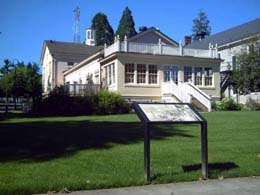On February 15, 1919, the Red Cross Convalescent House at Vancouver Barracks is dedicated. The American Red Cross presents the key to the building, located in Vancouver at 605 Barnes Avenue, to Colonel Charles W. Van Way (1874-1930), post commander. The house will provide comfort for patients at the Vancouver Barracks hospital, including American wounded from battlefields of France. In 1921 the Red Cross will turn over the facility to the army, and it will serve for many years as a noncommissioned officers club and service club. Located within the Fort Vancouver National Reserve, the house will be restored in 2004, and named E. B. Hamilton Hall to honor its wartime hostess, Red Cross worker Mrs. E. B. Hattie Hamilton (1893-1990). After long military service, it will go to provide a beautiful venue for weddings, parties, and other special events.
The Wartime Red Cross
The American Red Cross became a major national humanitarian organization during World War I and contributed substantially to the war effort. The organization provided the military with nurses, motor units, medical supplies, and more than 60 convalescent houses at military hospitals across the country. Its efforts during the war earned the organization the nickname "the Greatest Mother."
Two Red Cross convalescent houses were located in Washington state, one at Vancouver Barracks in Clark County and a second at Fort Lewis. The American Red Cross designed the facilities and funded their construction, and the military built the structures.
The convalescent houses around the country were build to a basic common design, with local modifications. Chicago architect Charles E. Fox (1879-1926) prepared a standard plan for a wood-frame building in a cruciform shape to represent the Red Cross's familiar logo.
Indoors, Red Cross symbols were used in woodwork, on the fireplace, and as other decorative features. To provide a homelike atmosphere, the "great room" of each house had comfortable wicker chairs, writing tables, and a fireplace. Patients could come there in hospital robes and not have to worry about the uniform of the day. At the end of the great room was a solarium, which doubled as a stage. For performances, chairs were rearranged to convert the room into an auditorium.
The building's two wings created the cross form. One wing had a school room and library and a kitchen. The other had a lounge, an office, and bathrooms. On the second floor of each wing were four bedrooms where patients' families could stay while visiting. Here they could cook meals and share their sadness or joy with the families of other wounded soldiers. Each house had a hostess who helped wounded soldiers recover and supported visiting families.
Vancouver Barracks Convalescent House
The Red Cross Convalescent House at Vancouver Barracks was a Georgian or Colonial style building. Its furnishings cost $30,000, all donated by the Red Cross. The facility included a full basement for recreation where a smoking room and a billiards rooms were installed. The warm, cream-colored basement walls were decorated with patriotic posters.
The first floor followed the standard design, with a great room, stage/solarium, lounge rooms, and kitchen. The great room and solarium had wicker furniture, red rugs, and highly polished hardwood floors. A Portland wicker shop handmade the chairs and tables. Chairs were arranged around a large fireplace that was decorated with a red cross. A bronze plaque on the fireplace read
"To the millions of women, whose hearts and hands are consecrated to this service; to the millions of men, rich and poor alike, throughout the country, who have contributed and sacrificed; and to the millions of children of our schools, the work of this house is dedicated. 1918."
The house provided comfort for patients at the Vancouver Barracks hospital, many just returned wounded from France. Recovering soldiers could sit in the chairs and read or just relax, and they were provided writing materials, books, and games. The house would show movies in the great room and brought in entertainers from Portland to perform. There were holiday parties with meals and snacks prepared in the kitchen.
On the second floor, each of the red-colored guest rooms memorialized a distinguished nurse. One honored Clara Barton (1821-1912), a Civil War nurse and founder of the American Red Cross. Also honored were Florence Nightingale (1820-1910); Alice Nellis (d. 1944), a Seattle nurse who served in the war; Jane Delano (1862-1919), who died in France during the war and is buried in Arlington National Cemetery; Edith Cavell (1865-1919), a British nurse executed by the Germans for helping soldiers escape; and Portland-born nurse G. Mary Welch, who served in France.
After the War
In 1921, with the war wounded back in their communities, the need for the convalescent houses diminished. The Red Cross turned the Vancouver Barracks facility over to the army, and for many years it served as a noncommissioned officer’s club and service club. The army-operated service club had a phonograph and music room and offered such activities as game nights, bingo, and holiday parties, while providing a relaxing place where a soldier could read a book or write a letter home.
In 2004 the former Red Cross convalescent house at Vancouver Barracks was restored and put to public use. It lies within the Fort Vancouver National Reserve and is available for weddings, group meetings, parties, and special events. The community room on the building's first floor was named E. B. Hamilton Hall to honor its wartime hostess, Mrs. E. B. "Hattie" Hamilton (1893-1990), a Red Cross worker who served as hostess until the building was turned over to the army in 1921. In 1922, she became director of the veterans’ reconstruction center at Tacoma’s Cushman Hospital, which provided occupational and physical therapy for wounded soldiers.

